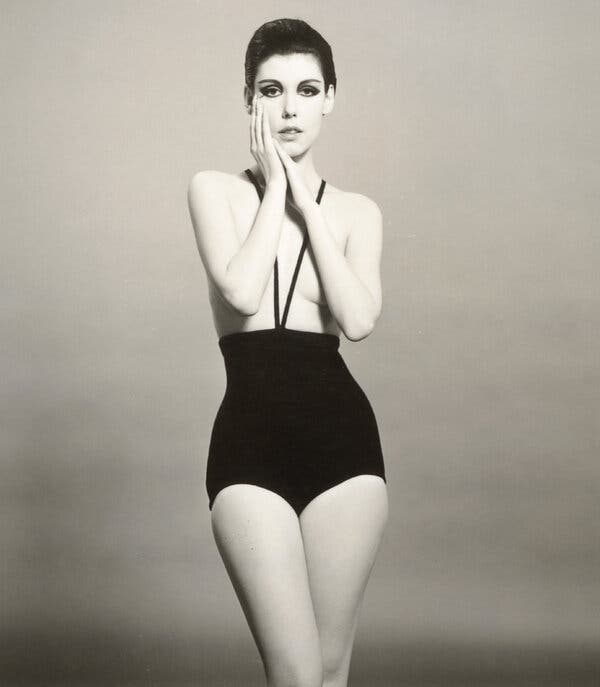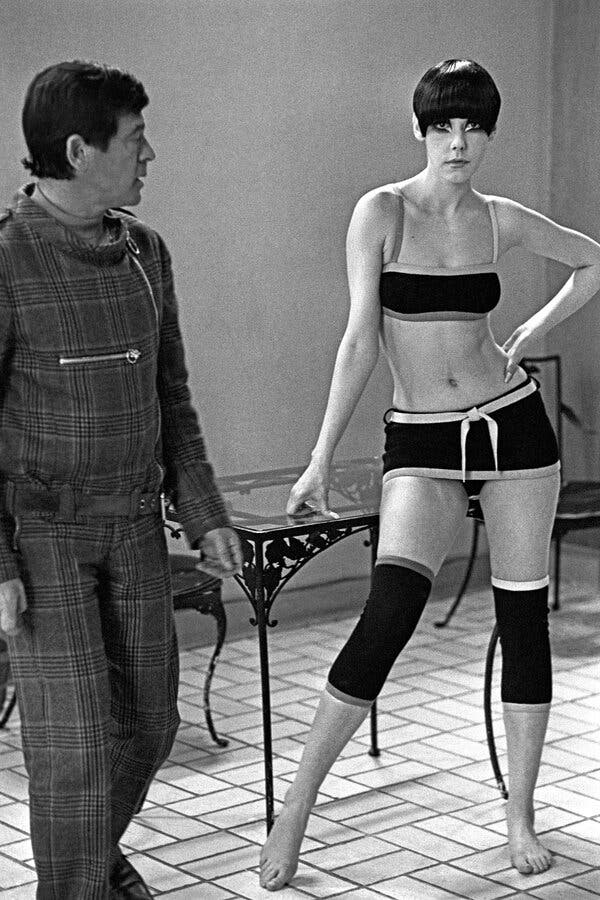
Peggy Moffitt, 86, Dies; Defined ’60s Fashion With a Bathing Suit and a Bob
She became famous for posing in the fashion designer Rudi Gernreich’s topless swimsuit. But she saw herself more as a performer than as a model.
Supported by
Peggy Moffitt, a model and muse who famously posed in the designer Rudi Gernreich’s topless bathing suit, and whose bob and heavy eye makeup helped define the look of the 1960s, died on Saturday at her home in Beverly Hills, Calif. She was 86.
Her son, Christopher Claxton, said the cause was complications of dementia.
Ms. Moffitt started working with Mr. Gernreich as a fitting and show model in 1962. “I entertained myself and the audience by regarding the collection as a play, with each outfit a new act or a new character,” she wrote in “The Rudi Gernreich Book” (1991), a collaboration with her husband, the photographer William Claxton, who took the topless photo. “In fact, I didn’t really model the clothes so much as perform them.”
She met Mr. Gernreich when she was working at a small boutique in Beverly Hills that was known for its unusual and avant-garde clothes. Ms. Moffitt was drawn to the humor in his designs.
She was initially hesitant about posing for a photo in his topless suit, but she decided to do it as long as some conditions were met: that she never wear it in public and that Mr. Claxton, who was best known for his portraits of jazz musicians, shoot it.
The suit, made famous by Mr. Claxton’s 1964 picture, made international news when it was banned in some countries and denounced by the Soviet newspaper Izvestia; it said in its criticism that the American way of life “is on the side of everything that gives the possibility of trampling on morals and interests of society for the sake of ego.”
The photo continued to follow her for decades, and in the process became somewhat of a nuisance. “Think of something in your life that took one-sixtieth of a second to do,” she said in 2012. “Now, imagine having to spend the rest of your life talking about it. I think it’s a beautiful photograph, but, oh, am I tired of talking about it.”
The fashion historian Jessica Glasscock, in an interview for this obituary last year, said: “In the 1960s, the idea of who could be a model really started to expand, and to include people who were not adhering to a traditional patrician, WASPy Western line of beauty. Peggy Moffitt was willing to look not traditionally pretty and explore other aesthetics. She was transgressing extreme femininity toward something that identified with the avant-garde ideal of the ’60s. She was working with her collaborators to make true art.”
In 1966, Ms. Moffitt appeared as a model in the Michelangelo Antonioni film “Blow-Up,” about a fashion photographer played by David Hemmings.
On Dec. 1, 1967, Ms. Moffitt appeared with Mr. Gernreich and the model Léon Bing on the cover of Time magazine. In that photo, she wore her hair in what became her signature geometric bob. Its shape, designed by the hairstylist Vidal Sassoon, framed her face and created clean, modern lines.

Her look was so recognizable that in 1968, the writer and illustrator William Pène du Bois published a children’s book called “Pretty Pretty Peggy Moffitt.”
In 1967, Mr. Claxton directed a seven-minute short, “Basic Black,” which is often cited as the first fashion film. It features clothes designed by Mr. Gernreich and worn by Ms. Moffitt, who saw modeling as not about striking a pose but about constant movement.
“His clothes conformed to the body and were flexible and free and more like dance wear,” Christopher Claxton, her son, said in an interview. “That appealed to her, and it was a common connection they had.”
Peggy Moffitt was born in Los Angeles on Oct. 2, 1937. Her father, Jack Moffitt, was a film critic and a screenwriter, and her mother, Mary (Came) Moffitt, raised their children, Peggy and her older sister, Barbara.
“She told me stories about going to the Brown Derby and other Hollywood restaurants during World War II with her parents and hearing air raid sirens and getting scared,” Mr. Claxton said. “She was a little girl on the banquette asking, ‘Can we go home now?’”
Ms. Moffitt grew up in the Hancock Park neighborhood of Los Angeles and attended Marlborough, a private all-girls school.
After she graduated, with a view to become an actress, she took classes at the Neighborhood Playhouse in New York City, where acting was taught by Sydney Pollack and dance by Martha Graham. Her classmates included Suzanne Pleshette and Robert Duvall.
She then moved back to Los Angeles and signed a contract with Paramount Pictures, landing small parts in the films “Senior Prom” (1958) and “Girls Town” (1959).
Ms. Moffitt was becoming disenchanted with the idea of making it in Hollywood when she met Mr. Claxton, a friend of the man she was dating at the time. “She saw a tall man come out of a small Jaguar XK140, and she asked, ‘Who is that?’ And he said, ‘Oh, that’s Bill Claxton,’” Christopher Claxton said.
She recognized his name from photos of his that she had seen on jazz albums. As family lore has it, she was arguing with her boyfriend and running downstairs from his apartment when she passed by Mr. Claxton as he was coming up. She said, “You must be William Claxton; I love your work.”
Ms. Moffitt found herself continuing to think about Mr. Claxton that night. Before much time had passed, she returned to her boyfriend’s apartment, hoping to find him still there. She invented the pretext of having forgotten something.
Mr. Claxton was overjoyed to see her again.
“He said, ‘Don’t leave,’” Christopher said. “They were basically out all night talking.”
They married in June 1959 in New York. She kept her name professionally but changed it legally to Peggy Moffitt Claxton. “The joke was that music people called her Mrs. Claxton, and fashion people called him Mr. Moffitt,” her son said. They remained married until Mr. Claxton died in 2008.
Ms. Moffitt’s son, a psychotherapist who manages his father’s photography archive, is her only immediate survivor.
In 2012, Ms. Moffitt’s private collection of Mr. Gernreich’s designs was featured in an exhibition, “The Total Look: The Creative Collaboration Between Rudi Gernreich, Peggy Moffitt and William Claxton,” which opened at the Museum of Contemporary Art’s Pacific Design Center satellite in West Hollywood, Calif. and later toured the country.
“I think a side of her liked being a muse very much, and there was a side that was terrified — that didn’t want to draw attention or to be looked at or be judged,” Christopher Claxton said. “But she also had this wild and experimental side of her that was about creating art and pushing boundaries. When she felt free and safe enough, she would do these wild and crazy things.”
Alex Traub contributed reporting.
Advertisement
